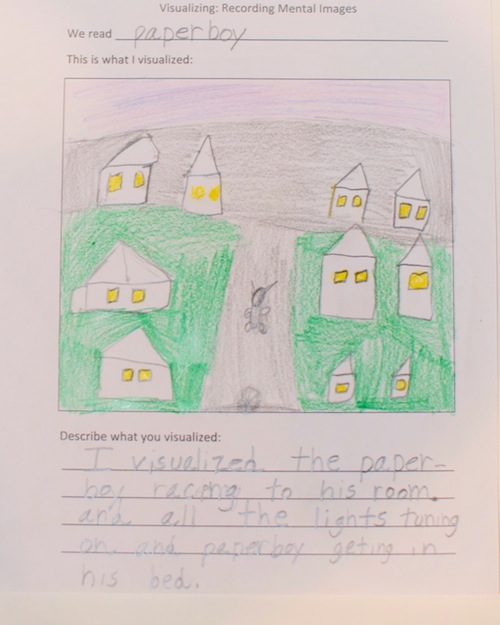Reading The Paperboy & Recording What We Visualized
It’s nice to love the books you use for teaching, and for me The Paperboy is no exception. Dav Pilkey tells the story of a paperboy delivering newspapers on a quiet Saturday morning. I have found that students become mesmerized by the sparse yet richly descriptive text, which helps young readers evoke mental images of their own.
We are coming to the end of our unit on visualizing and this is the perfect book that will allow me to assess how well students can visualize a story. As the Making Meaning program recommends, on the first day of instruction I read The Paperboy aloud without showing students the pictures, enabling them to create their own mental images. By this time within our unit of visualizing, students know the routine, they squint their eyes closed ready to listen. As the story is read aloud I stop at several spots through the book, allowing students to “Think, Pair, Share” about what they have visualized thus far. On day two of instruction the book is read again; this time we don’t stop to discuss what we’ve visualized, instead I let students know that after they’ve heard the story for a second time they will draw and write about what they visualized (which I just refer to as visualizing paper). I ask students to write a few sentences about what they visualized in addition to their pictures because it’s important students learn to communicate their ideas through different means.
Organizing What We Visualized
On the third day of instruction I gather a small group of students in a circle and place their work from the previous day in front of them. Here’s how the conversation went:
Teacher: Today we are going to organize our visualizing papers in a way that could tell the story of the paperboy to someone who has not yet read the book. How do you think we could organize our pictures?
Student: You mean like with a beginning, middle, and end?
Teacher: Would that help you organize the papers?
Student: Yeah, we could look at each one (their visualizations paper) and put them in separate piles, beginning, middle and end.
The other students agree that this is a strategy that would work well and they get started. They take turns reading and looking at each students’ visualizing papers deciding whether it would be in the beginning, middle, or end. As the students go through this process they build consensus through their conversation. Once they’ve placed each paper into a respective pile, it’s time to challenge them a bit more.
Sequencing Each Student’s Work
“I heard you all working together, you were reading the visualizing papers and talking about whether they belong in the beginning, middle or end. Now that you’ve organized the papers into three different piles how could we make sure each paper is in the right order?”
At first one of the students wanted to take each pile and place the visualizing papers side-by-side. I asked the student to show us how that would look. The student took the pile they all decided represented the beginning and placed the papers side-by-side.
“So will this work?” This is where wait time plays an important role; the hope is one of the students will notice that even though all the papers are from the beginning of the story, they’re not yet in the proper sequence.
“Well we can lay them out like this, but we have to put them in order-like this one of the paperboy in the garage has to go after he tip-toes down the stairs,” one student says, beginning to shift the papers.
The other students catch on. They decide to divide up their work: one student will sequence the beginning papers, two others will sequence the middle, and another works on sequencing the end. As they went to work I continued to ask them questions through this process, giving them an opportunity to deepen the conversation and to justify their decisions to their peers.
Reflecting on What We Learned
Once the students were finished, 15 visualizing papers were stretched out side-by-side across our carpet. The other students in the room were beginning to notice and I invited them over to take a closer look.
“How are your visualizing papers organized? How do you know they are organized this way? Are there any changes you would make?” We discuss these questions together as class. Looking at their pictures, they notice their own attention to detail as we discuss their visualizations. There is a panoramic image spread across our room; the still darkness of a Saturday morning at the far end, the orange and pink hues of sunrise through the middle and at the end a paperboy is tucked inside his bed as the whole world around him wakes up. The students are once again mesmerized; this time not by Mr. Pilkey’s work, but by their own. They have recreated a book through their collective imaginations.

